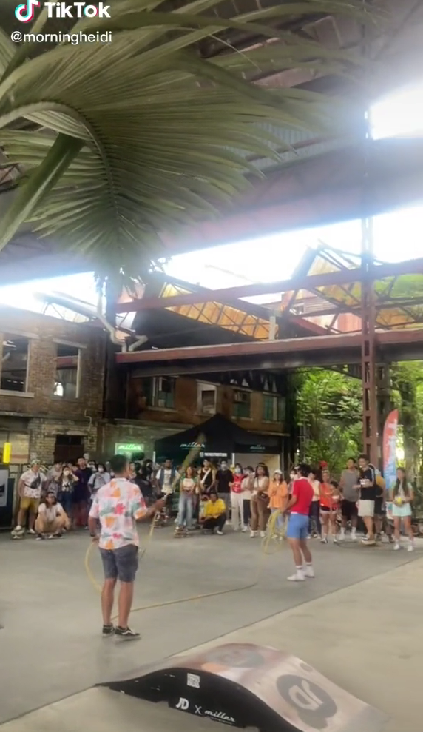Since the pandemic, we have seen a noticeable shift in how Generation Z consume content and how they express themselves. Though the pandemic has become an overused reason, it is a significant enough event that impacted the behaviors of our younger generation. The urban scene specifically has seen major changes due to the pandemic. Of course, the 2-year lockdown has brought on a series of emotions, mainly the fear of missing out (FOMO). The sudden gap that physical events used to fill remained a void that many of us are craving to fulfill hence resulting in an upward trend of social events happening post-pandemic.
Attending on-ground events provided a sense of community that was pretty much lost during the pandemic. The young now thirsts for this sense of belonging, to be part of an existing community, all while keeping their own individuality. This brought on indie events, largely targeting those who want to feel included, but is also open for the public to catch a glimpse of what these communities look like. Events as such do not revolve around just one thing, but it covers all categories from food, and music, to fashion, art, and sports. Most importantly, these events are very visually pleasing which is a necessity to factor in when targeting the younger crowd. A plus point is that most of the vendors are local.
However, the appeal is not just the fact that these events cater to such interests, but the people it attracts. The attendees come from various backgrounds and even influencers are often seen frequenting these events every other weekend. This results in a multitude of content being created for free to promote these events, as the attendees’ way of saying, “I’ve been there, done that”, like a checklist they need to tick off. The question is, why has it remained untapped by brands despite its obvious potential? The community usually safeguards indie events to prioritize local creators as a means of exposure. So the question remains, how can we ethically insert ourselves into this niche network?
1. Collaborate with Malaysian Indie Brands and Creators
Big-name brands are usually outcasted in such events because they are already established. Appearing in events like these would likely overshadow local indie brands which is the last thing they want. To establish your presence as a brand, you would first need to be open to expanding your horizons beyond B2C marketing. With the current younger generation, it’s not enough to just have them consume your brand. Their loyalty lies beyond a good-tasting product or a reliable name brand. The brand should and must reflect its consumer’s social values as well. Because of this, to appeal to them, the brand needs to become their enabler.
In the case of this topic, the brand can collaborate with Malaysian indie brands and creators to help them maximize their potential through a multitude of options. Brands can collaborate with local artists and sellers to create limited edition merchandise, contribute to their brand exposure via social postings, or provide free products for these vendors to add to their gift with purchase. Small efforts such as these go a long way in forming long-term loyalty between the brand and vendors, and the consumers as well because it effectively proves the brand to be a brand that cares and supports them. Some examples of successful activations include Taman Tugu’s Community Building efforts and Uniqlo’s Second Life Studio.
2. Stay Current and Relatable
The younger generations place importance on aesthetics, hence indie events become the ‘it’ place to be. Small efforts to beautify or aestheticize event spaces do bring high impact and return of investment to the brand as these naturally bring in user-generated content.
Staying current also means that brands must pay closer attention to what is happening within these communities. By understanding these groups and what makes them tick, brands can easily navigate marketing efforts to relate to them. It is a constant learning experience for brands to stay relevant but from the perspective of the consumers, this shows efforts from the brand in listening to feedback from their customer base.
3. Insert Yourself in the Conversation
If you were to take home one thing from this article, it would be this tip. We cannot stress enough how important it is to listen to what your consumers or the general public is saying about your brand. This is often overlooked despite how easy it is to do. There are plenty of existing social listening tools out there that automate this effort. Use this opportunity to engage with your consumers and make them feel included in your brand’s growth. By inserting yourself in the conversation, it bridges the gap between business and consumer more intimately and makes a brand likable. Brands like Mydin Malaysia and Wendy’s excel in this department where it becomes their mission to seamlessly connect with their audience.
This method is the simplest way of showing your consumers that you are aware of them as much as they are aware of your brand. It makes the audience feel seen and heard and opens up opportunities for the brand to understand its audience on the ground level.
These events and efforts are other avenues to connect with audiences to create a strong influence on the community. With the internet being more accessible and vocal, audiences now have a stronger share of voice compared to how it was before the pandemic. Acceptance from these communities mean intense loyalty but a slip-up could easily tear down the years of effort in building this relationship. Our advice is to be flexible, keep an open mind, and not be resistant to change.


